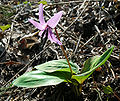Erythronium
| Erythronium | |
|---|---|

| |
| Erythronium dens-canis | |
| Scientific classification | |
| Kingdom: | |
| (unranked): | |
| (unranked): | |
| Order: | |
| Family: | |
| Subfamily: | |
| Tribe: | |
| Genus: | Erythronium |
| Type species | |
| Erythronium dens-canis | |
| Synonyms[1] | |
| |
Erythronium (fawn lily, trout lily, dog's-tooth violet, adder's tongue) is a genus of Eurasian and North American plants in the lily family.[2][3][4][5][6][7]
Species
Erythronium includes about 20–30 species of hardy spring-flowering perennial plants with long, tooth-like bulbs. Slender stems carry pendent flowers with recurved tepals in shades of cream, yellow, pink and mauve. Species are native to forests and meadows in temperate regions of the Northern Hemisphere.[8][1][9]
- Erythronium albidum Nutt. Small White Fawn-lily, White Fawn-lily, White Trout-lily - Ontario, east-central USA (MN to CT south to TX + AL)
- Erythronium americanum Ker-Gawl. Trout-lily, Yellow Trout-lily, Yellow Adder's-tongue, Yellow Dogtooth Violet - eastern Canada (Ontario to Labrador), eastern USA (ME to GA, west to Mississippi River)
- Erythronium californicum Purdy California Fawn-lily - northern California
- Erythronium caucasicum Woronow Caucasian Dog's tooth violet - Caucasus + Iran
- Erythronium citrinum S. Wats. Cream Fawn-lily - Oregon + northern California
- Erythronium dens-canis L. Dog's-tooth Violet - southern + central Europe from Portugal to Ukraine
- Erythronium elegans Hammond & Chambers Coast Range Fawn-lily - Oregon
- Erythronium grandiflorum Pursh Dogtooth Lily, Yellow Avalanche-lily, Yellow Fawn-lily - western Canada, western USA
- Erythronium helenae Applegate Pacific Fawn-lily - California (Sonoma, Napa, Lake Cos.)
- Erythronium hendersonii S. Wats. Henderson's Fawn-lily - Oregon + northern California
- Erythronium howellii S. Wats. Howell's Fawn-lily - Oregon + northern California
- Erythronium idahoense H.St.John & G.N.Jones - USA (MT ID WA)
- Erythronium japonicum Decne. Katakuri - Japan, Korea, Russia (Kuril Islands, Sakhalin), China (Jilin, Liaoning)
- Erythronium klamathense Applegate Klamath Fawn-lily - Oregon + northern California
- Erythronium krylovii Stepanov Tuvan Trout-lily - Russia (Tuva, Krasnoyarsk)
- Erythronium mesochoreum Knerr Midland Fawn-lily, White Fawn-lily - central USA (TX to NE + IN)
- Erythronium montanum S. Wats. White Avalanche-lily, Glacier Lily - BC, WA, OR
- Erythronium multiscapideum (Kellogg) A. Nels. & Kennedy Sierra Fawn-lily - California
- Erythronium oregonum Applegate Giant White Fawn-lily - BC, WA, California, Oregon
- Erythronium pluriflorum Shevock, Bartel & Allen >Manyflower Fawn-lily - Madera Co in California
- Erythronium propullans Gray Dwarf Trout-lily - Minnesota
- Erythronium purpurascens S. Wats. Purple Fawn-lily - California
- Erythronium pusaterii (Munz & J.T. Howell) Shevock, Bartel & Allen Kaweah Lakes Fawn-lily - Tulare Co in California
- Erythronium quinaultense G A Allen Olympic Fawn-lily - Olympic Peninsula in WA
- Erythronium revolutum Sm. Mahogany Fawn-lily - BC, WA, Oregon, California
- Erythronium rostratum W. Wolf Yellow Trout-lily - south-central USA
- Erythronium sajanense Stepanov & Stassova - Krasnoyarsk in Russia
- Erythronium sibiricum (Fisch. & C.A.Mey.) Krylov - Siberia, Kazakhstan, Xinjiang, Mongolia
- Erythronium sulevii (Rukšans) Stepanov - Altay Krai in Russia
- Erythronium taylorii Shevock & G A Allen Taylor's Fawn-lily - Tuolumne Co California
- Erythronium tuolumnense Applegate Tuolumne Fawn-lily - Tuolumne Co in California
- Erythronium umbilicatum Parks & Hardin Dimpled Trout-lily - southeastern USA (FL to KY + WV + MD)
- Photos
-
Erythronium albidum
-
Erythronium americanum
-
Erythronium californicum
-
Erythronium citrinum
-
Erythronium dens-canis
-
Erythronium grandiflorum
-
Erythronium helenae
-
Erythronium hendersonii
-
Erythronium japonicum
-
Erythronium montanum
-
Erythronium oregonum
-
Erythronium propullans
-
Erythronium purpurascens
-
Erythronium purpurascens, end of blooming
-
Erythronium revolutum
-
Erythronium sibiricum
Formerly included
Two species names were coined using the name Erythronium but referring to species now considered better suited to other genera. Here are links to help you find appropriate information
- Erythronium carolinianum, now called Uvularia perfoliata
- Erythronium hyacinthoides, now called Drimia indica
Uses
The bulb is edible as a root vegetable, cooked or dried, and can be ground into flour. The leaves can also be cooked as a leaf vegetable. In Japan, Erythronium japonicum is called katakuri, and the bulb is processed to produce starch, which is used for food and other purposes.
They are also widely grown as ornamental plants, with numerous hybrids and cultivars having been selected for garden use. Popular cultivars include Erythronium 'Pagoda', E. 'Sundisc', E. 'Joanna', E. 'Kondo', E. 'Citronella', E. californicum 'White Beauty', and E. 'Rosalind'. Propagation is best by seed in autumn or by division of bulbs, depending on species. Some species propagate vegetatively. The plant is also great as a ground cover, as it will spread over several years.
References
- ^ a b Kew World Checklist of Selected Plant Families
- ^ Jepson Manual
- ^ Flora of North America, Vol. 26 Page 153, Erythronium
- ^ Flora of China Vol. 24 Page 126 猪牙花属 zhu ya hua shu Erythronium Linnaeus, Sp. Pl. 1: 305. 1753.
- ^ Altervista Flora Italiana, Dente di cane, Dog's Tooth Violet, genere Erythronium
- ^ Clennett, J.C.B. (2006). A taxonomic revision of Erythronium L. (Liliaceae): 1-290. Thesis, Open University, Ardingly, U.K..
- ^ Clennett, C. (2014). The genus Erythronium: 1-158. Kew Publishing, Kew.
- ^ RHS A-Z encyclopedia of garden plants. United Kingdom: Dorling Kindersley. 2008. p. 1136. ISBN 1405332964.
- ^ Biota of North America Program 2013 county distribution maps
Bibliography
- "Erythronium 'Pagoda'". Royal Horrticultural Society. Retrieved 17 March 2014.
















